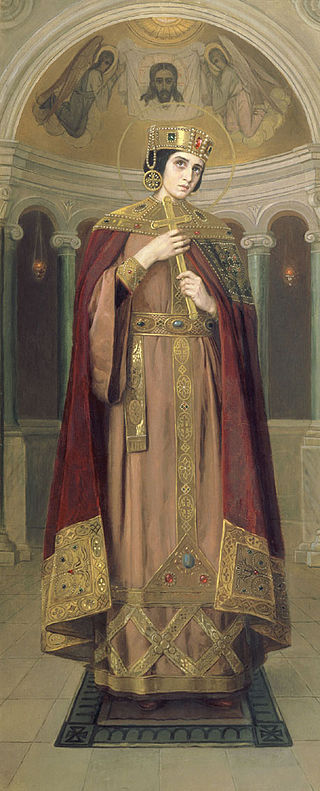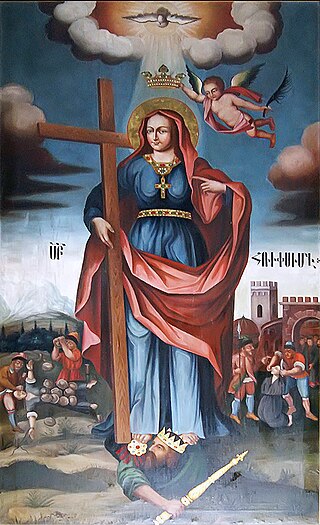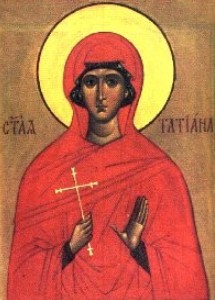
Agnes of Rome is a virgin martyr, venerated as a saint in the Catholic Church, Oriental Orthodox Church and the Eastern Orthodox Church, as well as the Anglican Communion and Lutheran Churches. She is one of several virgin martyrs commemorated by name in the Canon of the Mass, and one of many Christians martyred during the reign of the Roman emperor Diocletian.

Saint George, also George of Lydda, was an early Christian martyr who is venerated as a saint in Christianity. According to tradition, he was a soldier in the Roman army. Of Cappadocian Greek origin, he became a member of the Praetorian Guard for Roman emperor Diocletian, but was sentenced to death for refusing to recant his Christian faith. He became one of the most venerated saints, heroes and megalomartyrs in Christianity, and he has been especially venerated as a military saint since the Crusades. He is respected by Christians, Druze, as well as some Muslims as a martyr of monotheistic faith.

Catherine of Alexandria, also spelled Katherine is, according to tradition, a Christian saint and virgin, who was martyred in the early fourth century at the hands of the emperor Maxentius. According to her hagiography, she was both a princess and a noted scholar who became a Christian around the age of 14, converted hundreds of people to Christianity and was martyred around the age of 18. More than 1,100 years after Catherine's martyrdom, Joan of Arc identified her as one of the saints who appeared to and counselled her.

The calendar of saints is the traditional Christian method of organizing a liturgical year by associating each day with one or more saints and referring to the day as the feast day or feast of said saint. The word "feast" in this context does not mean "a large meal, typically a celebratory one", but instead "an annual religious celebration, a day dedicated to a particular saint".

Saints Faith, Hope, and Charity, are a group of Christian martyred saints who are venerated together with their mother, Sophia ("Wisdom").

September 16 - Eastern Orthodox liturgical calendar - September 18

July 16 - Eastern Orthodox Church calendar - July 18

Prisca was a young Roman woman allegedly tortured and executed for her Christian faith. The dates of her birth and death are unknown. She is revered as a saint and martyr in Eastern Orthodoxy, by the Catholic Church, and in the Anglican Communion.

Saint Anastasia is a Christian saint and martyr who died at Sirmium in the Roman province of Pannonia Secunda. In the Eastern Orthodox Church, she is venerated as St. Anastasia the Pharmakolytria, i.e. "Deliverer from Potions". This epithet is also translated as "One who Cures (Wounds)" in Lampe's A Patristic Greek Lexicon.

August 10 - Eastern Orthodox liturgical calendar - August 12

October 17 - Eastern Orthodox liturgical calendar - October 19

Alexandra of Rome was a Christian martyr and saint, known from Martyrdom of Saint George as either Emperor Diocletian's wife or the wife of Dacian, a Roman Prefect. She is also sometimes mistaken with Priscilla or Prisca.

January 11 - Eastern Orthodox liturgical calendar - January 13

January 17 - Eastern Orthodox liturgical calendar - January 19

Euphemia, known as the All-praised in the Eastern Orthodox Church, was a virgin martyr, who died for her faith at Chalcedon in 303 AD.

Tatiana Day, also known as Tatyana's Day or Students Day, is named after Saint Tatiana, a Christian martyr in 3rd-century Rome during the reign of Emperor Alexander Severus. It is also the name day for the name Tatiana. The Russian Orthodox Church celebrates St. Tatiana's feast on 12 January Julian, which corresponds to 25 January Gregorian in the 20th and 21st centuries. In Russia, the day is known as Students Day, commemorating the end of the winter university exams session.

Hripsime, also called Rhipsime, Ripsime, Ripsima, Ripsimia, Ripsimus, Arbsima or Arsema was a martyr of Roman origin; she and her companions in martyrdom are venerated as some of the first Christian martyrs of Armenia.

Christina of Bolsena, also known as Christine of Bolsena, or in the Eastern Orthodox Church as Christina the Great martyr, is venerated as a virgin martyr of the third century. Archaeological excavations of an underground cemetery constructed over her tomb have shown that she was venerated at Bolsena by the fourth century.

August 21 - Eastern Orthodox liturgical calendar - August 23

December 25 – Eastern Orthodox liturgical calendar – December 27














